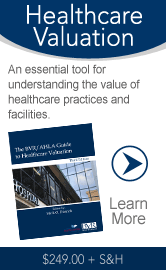 |
 |
Issue #18-1 | November 7, 2013

Five steps in structuring compliant physician pay packagesIn the October Healthcare Value Wire, we reported on a hospital that got into serious regulatory trouble over the issue of fair market value of physician compensation. While federal and state regulations require that physician compensation be commercially reasonable and at fair market value, there is very little regulatory guidance for meeting these valuation standards. Nevertheless, regulators are cracking down on healthcare providers that pay physicians amounts that exceed fair market value thresholds. A new white paper from the Advisory Board Co. offers five crucial steps in structuring compliant physician compensation packages. 1. Deconstruct total compensation. Physician employment agreements are multidimensional, so the definition of “total compensation” is the key factor in determining fair market value. It includes not only base salary, but also additional financial incentives, such as signing bonuses, retention bonuses, and educational loan repayment. Plus, physicians are often paid separately for responsibilities beyond traditional clinical duties. Payments for these extra responsibilities must be evaluated for fair market value separately, based on the nature, frequency, and scope of services provided. 4. Prepare extensive documentation. Since there are no clear guidelines from any of the regulatory agencies about what constitutes fair market value, organizations can inoculate themselves against future liability by extensively documenting their compensation methodology and decisions. Some examples of relevant information needed are: multiple years of data on the physician’s historical income; historical productivity data; the physician’s CV to demonstrate unique qualifications or skills included in the valuation; and any other relevant information, such as recruitment records, recent physician needs assessment, and the like. This documentation effort should continue even after a compensation agreement is signed. 5. Use independent experts early. CMS has indicated that valuation methods developed internally may receive more intensive scrutiny because they are susceptible to manipulation. Therefore, the use of outside independent auditors or valuation experts is important. Addressing any discovered red flags to achieve fair market value thresholds is more manageable early on in the negotiation process. Healthcare executives should not wait until the agreement is signed to enlist additional support in evaluating the fair market value or reasonableness of an arrangement. For more information: Compensation valuation in the healthcare industry is an emerging discipline. The BVR/AHLA Guide to Healthcare Industry Compensation and Valuation offers the first comprehensive body of knowledge on this topic and is a must-read for healthcare executives, valuation experts, consultants, attorneys, and anyone else who deals with physician compensation arrangements in healthcare. Strong M&A activity in healthcare Healthcare merger and acquisition deal volume was up nearly 16% in the third quarter of 2013 versus the previous quarter, with 267 deals announced. This year’s third quarter also outperformed the same quarter a year ago, up almost 20%, according to Irving Levin Associates. Growing momentum: “Deal-making momentum is growing, after a very low level of activity,” says Lisa E. Phillips, editor of Health Care M&A News. “The Long-Term Care and Hospital sectors were even stronger than in the second quarter, and compared with the third quarter in 2012. Biotechnology and Pharmaceuticals are still going strong, and we expect that to continue—at least until the major drug makers feel their pipelines are full again.” Hospital deals were the attention-getters in the third quarter, with Community Health Systems’ $7.6 billion bid for Health Management Associates coming on the heels of the Tenet Healthcare Corporation’s $4.3 billion acquisition of Vanguard Health Systems in the second quarter. Transactions of that size aren’t likely to be repeated in the near future, but deal volume in the sector will probably remain elevated as more stand-alone hospitals seek to join larger health systems in order to remain viable. “We expect to see even more M&A activity in the fourth quarter,” Phillips says. “Now that the Affordable Care Act is poised to take full effect in January, the uncertainty felt in many sectors is starting to dissipate. Health systems that have made strategic acquisitions such as physician medical groups will now turn their attention to long-term care, home health care and rehabilitation to fill out their care continuum requirements. We still expect a fluid market in Physician Medical Groups and continued consolidation among hospitals.” How Indian hospitals cut costs but maintain quality An op-ed piece in The Washington Post takes the position that hospitals in India could show U.S. hospitals how to save money without cutting quality. The authors of the editorial point to research they conducted that found that, while India’s healthcare system as a whole has many problems, some private hospitals provide quality healthcare at a fraction of U.S. prices. This holds true even when you adjust for salary differentials. How do they do it? They have innovated in three ways:
How realistic is it that U.S. hospitals will adopt the Indian model? “U.S. hospitals are constrained by regulations and norms unlike those in India,” say the authors of the editorial. “Nevertheless, some progressive U.S. hospitals are adopting some of the practices of our Indian exemplars, and more should follow their example.” The editorial was written by Vijay Govindarajan, a professor of international business at Tuck School of Business, Dartmouth College, and Ravi Ramamurti, a professor at Northeastern University and director of its Center for Emerging Markets. They are co-authors of the article “Delivering World-Class Healthcare Affordably,” in the current issue of Harvard Business Review. Reducing readmissions is a tough nut to crackTo avoid stiff penalties from Medicare for unnecessary readmissions, healthcare providers are focused on keeping patients from returning to the hospital within 30 days for the same problem or because of a complication from their previous stay. Hospitals are doing a better job implementing best practices to reduce 30-day readmission rates for cardiac patients, but even the best hospitals are still falling short in other key areas, according to new research from Yale University. The study, published in the October issue of JAMA Internal Medicine, revisited a 2012 Yale University survey of 537 U.S. hospitals taking part in the national Hospital to Home (H2H) Quality Improvement Program to reduce 30-day readmissions for patients with heart failure and acute myocardial infarction (AMI). Best practices: The H2H initiative establishes 10 best practices hospitals should follow to reduce readmissions. The 2012 study found that, on average, hospitals surveyed were using only 4.8 of the best practices at all times and that only 3% were using all 10 practices. The 10 best practices are:
In the follow-up study, 437 hospitals who responded showed marked improvement in several areas. It showed that 31% of hospitals were partnering with other hospitals to reduce readmissions compared to 23% in 2012 and that 61% of hospitals scheduled follow-up appointments for patients before they were discharged, compared with 52% in 2012. The new study also found that more hospitals had adopted a formal procedure for assessing a patient's risk of being readmitted (35% vs. 23%) and that more hospitals were providing post-care action plans for patients upon discharge (60% vs. 52%) and calling patients after discharge to follow up on their care plans (71% vs. 63%). The study also showed that hospitals made little or no improvement in several key areas. For example, it found that only 77% of hospitals provided patients with a full review of their medications and how to take them upon discharge compared to 78% in 2012 and that only 37% of hospitals had a process in place to ensure that a patient's primary care physician was notified within 48 hours of discharge, compared with 38% in 2012. On average, the study estimates that 25% of heart failure patients are readmitted to the hospital within 30 days of discharge and nearly 20% of AMI patients return within 30 days. These readmissions cost Medicare an estimated $17 billion in additional healthcare costs each year. Proposed solutions to physician shortage Three-quarters of healthcare organizations cite physician shortages as a threat to their organization, according to the HealthLeaders Media Industry Survey 2013: Strategic Imperatives for an Evolving Industry. In the past, the solution has been to create more physicians, but that will no longer work because too few medical students are choosing primary care. New research from UC San Francisco, published in the November 2013 issue of Health Affairs, recommends creation of physician-led patient care teams of licensed and unlicensed healthcare personnel who have been empowered to provide an expanded scope of care. Researchers also advocate increased participation by patients in providing more of their own care. Specific recommendations include:
"These recommendations are all evidence-based," says Thomas S. Bodenheimer, M.D., MPH, a UCSF professor of family and community medicine. "Research indicates that these approaches not only work, but actually tend to increase patient satisfaction compared with care by physicians." Community hospitals take action to boost bottom line Community hospitals are using various strategies to help them bounce back from financial setbacks, according to a recent survey (free registration required). Initiatives focus on ways to improve operational efficiencies, including:
The survey, conducted by Anthelio, a healthcare IT technology and consulting firm, also found that these organizations are moving forward with various IT projects. For example, 40% of respondents said they have completed an EHR implementation and are fully operational with the system, while almost all the rest responded that they have acquired and partially implemented such technology. Additionally, 71% of community hospital executives responding to the survey said their organization was in the process of implementing transitions to ICD-10, while 27% said they were planning to transition but have not yet started. Thirty-nine percent of respondents have spent or anticipate spending less than $100,000 on their ICD-10 transition, while 40% said they will spend $100,000 to $499,000, 13% will spend $500,000 to $999,000, and 9% will spend more than $1 million. |
|
||||||
1000 SW Broadway, Suite 1200, Portland, OR 97205
(503) 291-7963 | editor@bvhealthcarenews.com
www.BVResources.com/healthcare

